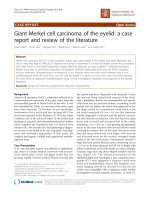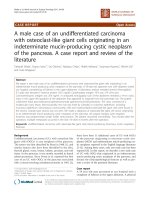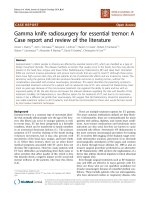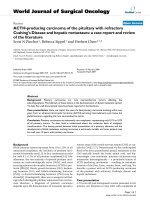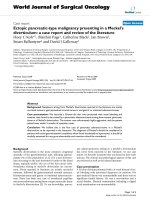Báo cáo khoa học: "Gastric outlet obstruction due to adenocarcinoma in a patient with Ataxia-Telangiectasia syndrome: a case report and review of the literature" pdf
Bạn đang xem bản rút gọn của tài liệu. Xem và tải ngay bản đầy đủ của tài liệu tại đây (511.42 KB, 5 trang )
BioMed Central
Page 1 of 5
(page number not for citation purposes)
World Journal of Surgical Oncology
Open Access
Case report
Gastric outlet obstruction due to adenocarcinoma in a patient with
Ataxia-Telangiectasia syndrome: a case report and review of the
literature
Iyore A Otabor
1
, Shahab F Abdessalam
2
, Steven H Erdman
3
, Sue Hammond
4
and Gail E Besner*
1
Address:
1
Department of Pediatric Surgery, Nationwide Children's Hospital and The Ohio State University College of Medicine, Columbus, OH
43205, USA,
2
Department of Pediatric Surgery, Children's Hospital of Omaha, Omaha, NE 68114, USA,
3
Division of Gastroenterology,
Hepatology and Nutrition, Nationwide Children's Hospital and The Ohio State University College of Medicine, Columbus, OH 43205, USA and
4
Department of Pathology and Laboratory Medicine, Nationwide Children's Hospital and The Ohio State University College of Medicine,
Columbus, OH 43205, USA
Email: Iyore A Otabor - ; Shahab F Abdessalam - ;
Steven H Erdman - ; Sue Hammond - ;
Gail E Besner* -
* Corresponding author
Abstract
Background: Ataxia-Telangiectasia syndrome is characterized by progressive cerebellar
dysfunction, conjuctival and cutaneous telangiectasias, severe immune deficiencies, premature aging
and predisposition to cancer. Clinical and radiographic evaluation for malignancy in ataxia-
telangiectasia patients is usually atypical, leading to delays in diagnosis.
Case presentation: We report the case of a 20 year old ataxia-telangiectasia patient with gastric
adenocarcinoma that presented as complete gastric outlet obstruction.
Conclusion: A literature search of adenocarcinoma associated with ataxia-telangiectasia revealed
6 cases. All patients presented with non-specific gastrointestinal complaints suggestive of ulcer
disease. Although there was no correlation between immunoglobulin levels and development of
gastric adenocarcinoma, the presence of chronic gastritis and intestinal metaplasia seem to lead to
the development of gastric adenocarcinoma. One should consider adenocarcinoma in any patient
with ataxia-telangiectasia who presents with non-specific gastrointestinal complaints, since this can
lead to earlier diagnosis.
Background
Ataxia-Telangiectasia (A-T) was first reported in 1926 in
three patients that presented with progressive chore-
oathetosis and ocular telangiectasias [1]. By 1958, it was
recognized as a distinct disease process and named ataxia-
telangiectasia [2]. The most common initial abnormalities
noted are balance and gait problems [3]. Unsteadiness
and truncal ataxia typically appear before 3 years of age,
with slurred speech by 5 years of age. Patients are usually
wheel-chair bound by 10 years of age due to excessive fall-
ing coupled with slow reflexes that cause serious bodily
injuries. About a third of the patients present with severe
immunodeficiencies accompanied by severe sino-pulmo-
nary infections with non-opportunistic organisms, a third
Published: 12 March 2009
World Journal of Surgical Oncology 2009, 7:29 doi:10.1186/1477-7819-7-29
Received: 11 December 2008
Accepted: 12 March 2009
This article is available from: />© 2009 Otabor et al; licensee BioMed Central Ltd.
This is an Open Access article distributed under the terms of the Creative Commons Attribution License ( />),
which permits unrestricted use, distribution, and reproduction in any medium, provided the original work is properly cited.
World Journal of Surgical Oncology 2009, 7:29 />Page 2 of 5
(page number not for citation purposes)
have moderate immunodeficiencies, and a third have no
signs of immunodeficiency [4]. Serum levels of alpha feto-
protein (AFP) are usually increased in A-T patients [4-6].
There appears to be a direct correlation between serum
AFP levels and age [7].
While there have been significant improvements in diag-
nostic modalities for A-T, there is still no cure and treat-
ment is mainly symptomatic. Patients with A-T have a 70–
250 fold increased risk for developing a lymphoreticular
malignancy [8,9]. However, clinical and radiographic
diagnosis of malignancy in these patients can be difficult
because the presentation is usually atypical and may be
confused with the infectious processes commonly associ-
ated with immunodeficiency syndromes. Six cases of gas-
tric cancer associated with A-T have been reported in the
literature in patients ages 14–26 years; of these, four cases
were reported in the English literature with the last case
reported in 1979 [10]. We present the case of a 20 year old
female with ataxia-telangiectasia who was transferred to
our institution with a diagnosis of pancreatic abnormal-
ity. Further diagnostic evaluation revealed gastric adeno-
carcinoma that was resected.
Case presentation
The patient is a 20 year old female that was diagnosed
with ataxia-telangiectasia syndrome at 3 years of age. She
had severe ataxia and was wheelchair bound by 8 years of
age. She presented with a 4 week history of non-bilious
emesis, early satiety, decreased appetite and a 35 lb weight
loss over a one year period. The patient had undergone
evaluation for these symptoms at her local hospital. A CT
scan of the abdomen suggested a pancreatic mass prompt-
ing transfer to our institution. On examination, she had
notable speech and cognitive delays with scleral tel-
angiectasias, muscle wasting and other features of malnu-
trition. Her abdominal examination revealed a soft, non-
distended abdomen with no palpable masses. Her labora-
tory studies were remarkable for hypokalemic, hypochlo-
remic metabolic alkalosis, a pre-albumin level of 15 mg/
dL (normal: 23–48 mg/dL), an IgG level of 461 mg/dL
(normal: 546–1842 mg/dL) and an absolute lymphocyte
count of 187/cu mm (normal: 1000–4800/cu mm).
Other immunoglobulin levels [IgA (186 mg/dL), IgM (70
mg/dL) and IgE (<1 U/mL] were within normal limits. She
was started on total parenteral nutrition (TPN) immedi-
ately upon admission. A repeat CT scan of the abdomen
revealed a dilated, hypertrophied stomach consistent with
chronic gastric outlet obstruction, abnormal thickening of
the antrum and pylorus, and a normal appearing pancreas
(Figure 1). Esophagogastroduodenoscopy (EGD) demon-
strated diffuse gastritis and esophagitis with a normal
appearing duodenum. She was subsequently placed on
Pantoprazole
®
, Azithromycin
®
and Metronidazole
®
for pre-
sumed Helicobacter pylori infection, and kept on continu-
ous nasogastric decompression for persistent emesis.
Gastric biopsies identified non-candida fungi on the gas-
tric epithelium and rare lymphoid aggregates in the lam-
ina propria. A Diff-Quik stain for Helicobacter pylori on the
biopsied specimen was negative prompting discontinua-
tion of the triple antibody therapy. Several attempts to
remove the nasogastric tube were unsuccessful, and so an
upper GI series was obtained. This revealed a complete
gastric obstruction (Figure 2). To address a possible sub-
mucosal infiltrative process such as lymphoma, a repeat
CT scan of the abdomen with oral contrast demonstrating markedly dilated stomach, abnormal thickening in the region of the antrum and pylorus of the stomach, and adjacent pan-creas thinned due to compression from dilated stomachFigure 1
CT scan of the abdomen with oral contrast demon-
strating markedly dilated stomach, abnormal thick-
ening in the region of the antrum and pylorus of the
stomach, and adjacent pancreas thinned due to com-
pression from dilated stomach. There was no intra-
abdominal adenopathy.
UGI demonstrating complete gastric outlet obstructionFigure 2
UGI demonstrating complete gastric outlet obstruc-
tion.
World Journal of Surgical Oncology 2009, 7:29 />Page 3 of 5
(page number not for citation purposes)
EGD was performed to obtain deeper biopsy specimens.
At this time, the scope could not be advanced into the
duodenum. Deep antral biopsies identified gastric adeno-
carcinoma. A metastatic workup including chest CT scan
and bone scan revealed no evidence of disease. After hav-
ing received almost 2 weeks of TPN, she was taken to the
operating room for exploratory laparotomy. Intra-opera-
tively, she was found to have a large gastric mass involving
the distal stomach which was determined to be resectable.
During the dissection, there were dense adhesions
between the posterior wall of the duodenum and the pan-
creas that were able to be divided. The tumor was resected
by removing 2/3 of the distal stomach, with a minimum
of 4.5 cm margins proximally and 2 cm margins distally.
These margins were free of tumor on frozen and final
pathologic exam. The pancreatic surface in the area of
resection was biopsied in the operating room due to the
finding of adhesions between the stomach and pancreas.
The frozen sections showed no evidence of malignancy
however, the permanent sections later revealed the pres-
ence of a focus of tumor. The patient was reconstructed
with a Billroth II gastrojejunostomy after oversewing of
the duodenal stump, and a feeding jejunostomy tube and
Blake drain were placed. Final histologic evaluation
revealed a well to moderately differentiated invasive intes-
tinal-type adenocarcinoma of the stomach with invasion
through the muscularis to the serosa, and multifocal vas-
cular and lymphatic invasion.
Postoperatively, the patient initially did well, but then
developed increased output from her abdominal drain
containing high amylase and lipase levels. An UGI series
revealed no evidence of anastamotic leak. On post opera-
tive day 7 she developed bloody emesis which resolved
spontaneously. However, she developed increasing
abdominal pain and a CT scan of the abdomen showed
ascites with small bowel obstruction. She was therefore
returned to the operating room for exploratory laparot-
omy which revealed diffuse ascites, an intact gastrojeju-
nostomy, and an obstruction in the afferent limb of the
gastrojejunostomy due to large blood clots. The clots were
removed via an enterotomy in the afferent limb, and the
pancreatic ascites was widely drained. She had a pro-
longed hospital course but recovered from surgery and
was discharged to home on hospital day 48. Two months
after surgery she was on continuous jejunostomy tube
feeds and eating small amounts by mouth. However,
three months after surgery she was refusing to eat,
appeared uncomfortable although without complaints,
and subsequently declined clinically thereafter. She
expired 100 days from initial diagnosis while under hos-
pice care, presumably due to wasting secondary to meta-
static adenocarcinoma.
Discussion
Our patient was the last of three children born at term to
a healthy 23 year old mother. Her birth weight was 2.45
kg; there is no family history of congenital immunodefi-
ciency disorder; her two older siblings are healthy and liv-
ing. The patient was initially seen at age 18 months due to
loss of previous ability to walk, poor head control and
tendency to walk and fall to the right. By age 3 years, she
had progressively worsening ataxia, choreoathetosis,
prominent ocular telangiectasias and an elevated alpha
fetoprotein of 205.4 ng/mL (normal 0–6 ng/mL) consist-
ent with ataxia-telangiectasia. All immunoglobulin levels
were within normal limits except IgM and IgE, which were
slightly depressed. The patient did not receive routine
immunoglobulin administration since her disorder was
mostly neurologic.
Ataxia-Telangiectasia, an autosomal recessive disorder, is
characterized by early onset progressive cerebellar ataxia,
oculocutaneous telangiectasia, immune deficiency, and
cancer. The causative gene, A-T mutated (ATM) on chro-
mosome 11q22-23, codes for a 350 kDa Ser/Thr protein
kinase that belongs to the phosphoinositide 3-kinase
(PI3K)-related protein kinase (PIKK) family. ATM with
associated proteins function primarily as phosphorylating
agents in controlling genomic stability and regulating
lymphocyte maturation. Although rare, A-T is the most
common primary immunodeficiency syndrome listed in
the Immunodeficiency Cancer Registry (ICR), and
approximately one-third of A-T patients develop a malig-
nancy during their lifetime. These patients most com-
monly develop lymphoreticular neoplasms. ATM has also
been implicated in breast, lung, head and neck carcinoma,
and is associated with a poor prognosis in adult patients
with advanced gastric cancer [11].
Gastric adenocarcinoma accounts for the majority of
malignant gastric cancer. It arises from the glandular epi-
thelium of the gastric mucosa. The most widely used Lau-
ren histologic classification system divides gastric
adenocarcinoma into two types – intestinal and diffuse
[12]. The intestinal type, which is usually well-differenti-
ated, originates from recognizable precancerous condi-
tions such as gastric atrophy or intestinal metaplasia. It
has a tendency to form glandular structures and spreads to
distant organs hematogenously. The diffuse type is typi-
cally poorly differentiated, lacks gland formation and is
composed of signet ring cells. Early metastases via lym-
phatic invasion commonly occur. Our patient had moder-
ately differentiated intestinal type adenocarcinoma
(Figure 3).
Six cases of gastric cancer associated with A-T have been
reported in the literature in patients ages 14–26 years; of
these, four cases were reported in the English literature
World Journal of Surgical Oncology 2009, 7:29 />Page 4 of 5
(page number not for citation purposes)
with the last case reported in 1979 (Table 1) [13-15]. A
single case series from four different hospitals revealed
twelve patients with A-T and associated malignancy, with
one patient that probably had gastric mucinous adenocar-
cinoma [16]. In the normal population, the median age
for diagnosis of gastric adenocarcinoma is 70 years.
Known risk factors for gastric adenocarcinoma in the gen-
eral population include Helicobacter pylori infection,
atrophic gastritis, a diet high in nitrates and salt, fried or
fatty foods, low fruits and vegetables intake, smoking,
male gender, and positive family history. As opposed to
gastric carcinoma in the general population, gastric carci-
noma in A-T patients occurs in the first or second decade
of life and has an extremely poor prognosis, with the long-
est reported survival time of 5 months. It is important to
recognize that the risk of gastric carcinoma is also elevated
in patients with other primary immune deficiencies such
as X-linked agammaglobulinemia, common variable
Hematoxylin and eosin stained sections of the gastric adenocarcinoma resected from our patientFigure 3
Hematoxylin and eosin stained sections of the gastric adenocarcinoma resected from our patient. [A] Cytologi-
cal features of malignant glands; the cells are irregularly shaped with high nucleus to cytoplasm ratio and loss of nuclear polar-
ity. The small dark cells are inflammatory cells (100× enlargement) [B] This area of tumor is in the serosa; there is
redemonstration of irregular glands formed by tumor cells of varying sizes and orientation, with prominent nucleoli. The large
clear spaces are fat cells (200× enlargement).
Table 1: Previous cases of gastric adenocarcinoma associated with Ataxia-Telangiectasia Syndrome.
Authors Symptoms on presentation Age at diagnosis (years)/Sex Time to death (days)
Haerer A et al. (1969)
[13]
Nausea, intractable vomiting and weight
loss
21/F ?
Abdominal pain, nausea, vomiting and
weight loss
19/F 90
Kondo K and Horikawa Y (1975)
[14]
Severe mental retardation, gait and speech
disturbances, nystagmus
21/F ?
22/F Gastric cancer confirmed at autopsy
Watanabe A et al. (1977)
[15]
Abdominal pain, vomiting, postive fecal
occult blood test
14/M 150
Frais MA (1979)
[10]
Weight loss, anorexia and dyspepsia 26/M 5
Year of publication in parentheses
World Journal of Surgical Oncology 2009, 7:29 />Page 5 of 5
(page number not for citation purposes)
immune deficiency, and X-HIGM syndromes. In patients
with X-linked agammaglobulinemia, chronic atrophic
gastritis, intestinal metaplasia and pernicious anemia
appear to play an important role in the pathogenesis of
gastric adenocarcinoma [17,18]. Thus, it is advisable to
extend increased awareness of the possibility of gastric
carcinoma to the entire population of primary immuno-
deficient patients.
The A-T patients with gastric carcinoma reported to date
presented with non-specific signs of abdominal pain, nau-
sea, vomiting and weight loss. Three patients including
ours had initial clinical findings suggestive of ulcer dis-
ease. On endoscopy, our patient was noted to have diffuse
gastritis, which may have contributed to the development
of her adenocarcinoma. All cases reported in the literature
had metastatic disease at the time of exploratory laparot-
omy. Although depressed immunoglobulin levels are
associated with increased risk of malignancy, there was no
significant correlation between abnormal immunoglobu-
lin levels and the development of gastric cancer in those
patients in whom levels were checked, suggesting that
injury to the gastrointestinal mucosa in the form of
chronic gastritis may predispose these patients to the for-
mation of gastric adenocarcinoma in light of their poor
immunologic defense systems. Our patient further dem-
onstrates the challenges associated with diagnosing and
caring for these complex patients.
Conclusion
Although rare, one should consider adenocarcinoma in
any patient with ataxia-telangiectasia greater than 10 years
of age who presents with non-specific gastrointestinal
complaints, since this can lead to earlier diagnosis. Given
the poor survival outcome, palliative rather than curative
measures may be necessary for unresectable disease. The
role of chemo-radiation therapy in A-T patients is limited
as it may further predispose the patient to the risk of
developing new malignancies [19]. Continuous research
efforts will increase our understanding of this disease
process and the role of the ATM gene in carcinogenesis.
Consent
Written informed consent was obtained from the legal
guardian for publication of this case report and accompa-
nying images. A copy of the written consent is available
for review by the Editor-in-Chief of this journal.
Competing interests
The authors declare that they have no competing interests.
Authors' contributions
IAO wrote the manuscript and performed the literature
and case review; SFA was involved in the initial operation,
performed a detailed literature review, and critically
edited the manuscript; SHE performed the upper endo-
scopies, literature review, and critical review of the manu-
script; SH was responsible for all aspects of the manuscript
related to the histologic studies; GEB was involved in the
patient's initial operation, and assisted in the writing and
critical review of the manuscript. All authors read and
approved the final manuscript.
References
1. Syllaba L, Henner K: Contribution a l'independence de
l'athetose double idiopathique et congenitale. Rev Neurol
(Paris) 1926, 1:541-562.
2. Boder E, Sedgwick RP: Ataxia-Telangiectasia: A familial syn-
drome of progressive cerebellar ataxia, oculocutaneous tel-
angiectasia and frequent pulmonary infection. Pediatrics 1958,
12(4):526-554.
3. Woods CG, Taylor AM: Ataxia telangiectasia in the British
Isles: the clinical and laboratory features of 70 affected indi-
viduals. Q J Med 1992, 82(298):169-179.
4. Perlman S, Becker-Catania S, Gatti RA: Ataxia-telangiectasia:
diagnosis and treatment. Semin Pediatr Neurol 2003, 10:173-182.
5. Waldmann TA, McIntire KR: Serum-alpha-fetoprotein levels in
patients with ataxia-telangiectasia. Lancet 1972, 2:1112-1115.
6. Jason JM, Gelfand EW: Diagnostic considerations in ataxia-tel-
angiectasia. Arch Dis Child 1979, 54:682-686.
7. Stray-Pedersen A, Borresen-Dale AL, Paus E, Lindman CR, Burgers T,
Abrahamsen TG: Alpha fetoprotein is increasing with age in
ataxia-telangiectasia. Eur J Pediatr Neurol 2007, 11:375-380.
8. Morrell D, Cromartie E, Swift M: Mortality and cancer incidence
in 263 patients with ataxia-telangiectasia. J Natl Cancer Inst
1986, 77:89-92.
9. Filipovich AH, Heinitz KJ, Robison LL, Frizzera G: The immunode-
ficiency cancer registry. Am J Hematol Oncol 1987, 9:183-184.
10. Frais MA: Gastric adenocarcinoma due to ataxia-telangiecta-
sia (Louis-Bar syndrome). J Medical Genetics 1979, 16:160-161.
11. Kang B, Guo RF, Tan XH, Zhao M, Tang ZB, Lu YY: Expression sta-
tus of ataxia-telangiectasia-mutated gene correlated with
prognosis in advanced gastric cancer.
Mutation Research 2008,
638:17-25.
12. Lauren P: The two histological main types of gastric carci-
noma: diffuse and so-called intestinal-type carcinoma. An
attempt at histo-clinical classification. Acta Pathol Microbiol
Scand 1965, 64:31-49.
13. Haerer AF, Jackson JF, Evers CG: Ataxia-telangiectasia with gas-
tric adenocarcinoma. JAMA 1969, 210:1884-1887.
14. Kondo K, Horikawa Y: Spinocerebellar degeneration. Ataxia-
telangiectasia and malignant tumour. [Japanese]. Naika no
Ryôiki (Domain of Internal Medicine) 1975, 35:623-626.
15. Watanabe A, Hanazono H, Sogawa H, Takaya H: Stomach cancer
of a 14-year-old boy with ataxia-telangiectasia. Tohoku J Exp
Med 1977, 121:127-131.
16. Murphy RC, Berdon WE, Ruzal-Shapiro C, Hall EJ, Kornecki A, Dane-
man A, Brunelle F, Campbell JB: Malignancies in pediatric
patients with ataxia telangiectasia. Pediatr Radiol 1999,
29:225-230.
17. Lavilla P, Gil A, Rodríguez MC, Dupla ML, Pintado V, Fontán G: X-
linked agammaglobulinemia and gastric adenocarcinoma.
Cancer 1993, 72:1528-1531.
18. Bachmeyer C, Monge M, Cazier A, Le Deist F, de Saint Basile G,
Durandy A, Fischer A, Mougeot-Martin M: Gastric adenocarci-
noma in a patient with X-linked agammaglobulinemia. Eur J
Gastroenterol Hepatol 2000, 12:1033-1035.
19. Makis A, Polychronopoulou S, Haidas S: Osteosarcoma as a sec-
ond tumor after treatment for primary non-hodgkin's lym-
phoma in a child with ataxia-telangiectasia. Presentation of
a case and review of possible pathogenetic mechanisms. J
Pediatr Hematol Oncol 2004, 26:444-446.

